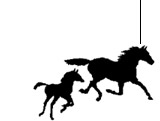|
Last Roundup Feared
For Canada's wild horses the future appears bleak
Only a handful of the animals left in Canada/U.S.
Senate moves to protect dwindling herds
About 200 years ago, 3 million wild horses roamed most of the North American continent. Today, fewer than 8,000 of the animals remain.
Last month, the U.S. Senate banned the persistent, ongoing destruction of the surviving stock in the United States when it approved the American Horse Slaughter Prevention Act. But it's unlikely that Canada will follow the U.S. lead.
Even though some of North American's surviving wild horses are in Canada, there are no specific wild horse conservation laws here, and none are pending.
There were originally more than 1 million wild horses in Canada, according to the Canadian Wild Horse Preservation Society. By 1965, only four small herds survived - three in British Columbia totalling fewer than 200 horses, and another herd of about 200 horses in the Siffleur Wilderness Area near Calgary. None of the British Columbia herds remain.
In Alberta, wild horse numbers fell so fast that in 1959, the Calgary Herald predicted total extinction was imminent. The animals were being shot for sport, slaughtered for dog food and rounded up for rodeo stock. Wild horses at that time fetched $400 to $500 apiece at Calgary slaughterhouses.
By 1974, the official wild horse population in Alberta was only "about 1,000." Horse-hunting on Crown land was restricted after that, but not on private property. Under Alberta's Stray Animals Act, wild horses are considered domestic livestock, not wildlife.
Widespread killing, inhumane treatment and a looming collapse of American wild horses prompted the new U.S. law. Sponsors of the legislation claim wild horses merit protection owing to their important historical role in the American West. The new law completely protects the animals, but only for one year. A permanent ban on wild horse slaughter is expected soon, according to the Society for Animal Protective Legislation.
Some biologists think Canada's last surviving herd, in Alberta, is now too small to maintain its genetic integrity, and might be doomed.
There is no federal wild horse protection in Canada, since Environment Canada considers the horses to be introduced foreign animals, not native, and do not qualify for protection under the Species at Risk Act.
That situation is based on semantics, not science, wild horse advocates claim. The official definition of "native" does not contemplate species brought to North America by humans, even if they originated in North America.
"I admit it is an iffy distinction in the case of horses," says a mammal expert and former member of the endangered wildlife committee.
Palaeontologists believe that equines ancestral to all of the world's horses evolved originally in North America from "eohippus" stock that first appeared about 50 million years ago. Gradually, Equus callabus, the modern horse, took shape.
According to Jim Burns of the Provincial Museum of Alberta, some of the North American horse stock relocated to Eurasia, while those that remained in North America disappeared mysteriously about 10,000 years ago.
Tests show that horses in the Yukon Territory and elsewhere in Canada before that were Equus callabus, says Richard Harington, curator of quaternary zoology emeritus at the Canadian Museum of Nature.
Archaeologists doubt that any of the original horse stock survived too long into post-glacial times (about 10,000 years ago). It was probably wiped out by prehistoric human hunters. But, the horse stock that migrated to Eurasia diversified naturally and artificial breeding took place.
In the early 1600s, Spanish Conquistadores brought mustangs to North America from Spain. Escapees gave rise to millions of wild horses that soon established themselves in much of North America.
They arrived in Alberta and Saskatchewan by 1776, and in British Columbia by 1809. They were direct descendants of the Spanish mustangs and the ancestors of Canada's current wild horses.
According to Philip Sponenberg, a biologist and wild horse expert at the University of Virginia, the surviving Canadian wild horses are probably the purest genetic reservoir of Spanish mustangs in the Western Hemisphere. They are Equus callabus, the species that developed originally in North America, relocated to Eurasia, and were brought back to the New World by the Spaniards.
Blood typing tests involving horses from the existing Alberta herd confirm a direct genetic link with the Spanish mustangs.
Utah and Oregon wild horses share some of those same genetic traits. They are "very close" genetically to the Equus callabus horses that originally evolved in North America, Harington says.
"We have never appreciated our wild horses in Canada," says Steve Howlett, a Manitoba rancher who owns a horse derived from the Alberta stock. "We have shot them and slaughtered them almost to oblivion."
Oct. 15, 2005 Toronto Star
Robert Alison
Special to the Star
"Help us lead Canada's horses away from barbarism . .
and into the protected pastures of a civilized
nation."
|


